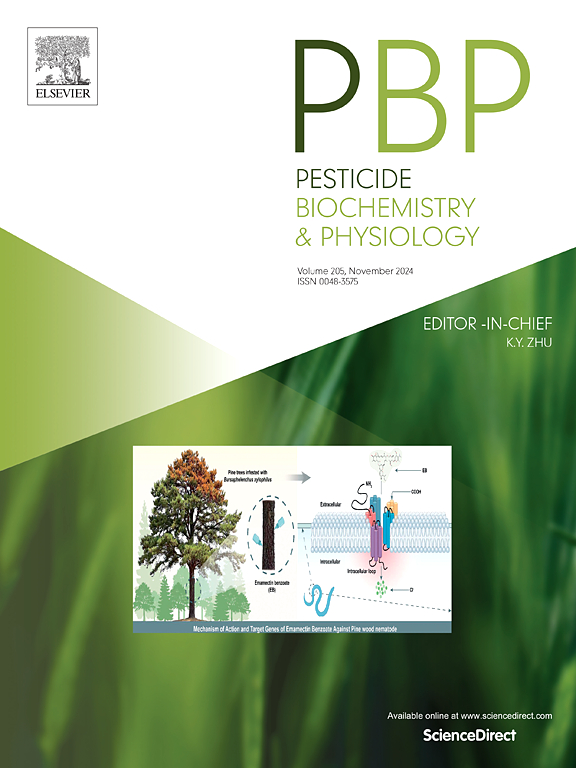β-三酮细精子素对埃及伊蚊的毒性作用模式
IF 4.2
1区 农林科学
Q2 BIOCHEMISTRY & MOLECULAR BIOLOGY
引用次数: 0
摘要
细尾精酮(leptospermoone)是一种天然β-三酮,是麦芦卡油(Leptospermum scoparium)的主要成分,是一种已知的植物HPPD抑制剂,经鉴定,通过局部接触和跗部接触,其LD50值分别为150 ng/mg和357 ng/cm2,可诱导埃及伊蚊成虫快速抑制和产生高毒性。尽管细精素对蚊子有毒,但对蜱虫、蜜蜂或果蝇无毒,这表明细精素对昆虫具有高度的特异性。重要的是,钩端精子素对非吸血和吸血蚊子的毒性相同,表明其作用方式不是通过抑制HPPD。分子模型表明,钩端精子素与哺乳动物磺酰胺碳酸酐酶(CA)抑制剂具有高度的结构相似性。用蚊子中肠匀浆或纯化CA进行体外效价测定,证实钩端精子素对伊蚊有抑制作用。埃及伊蚊CA,但不是哺乳动物CA。CAs是调节组织pH值的金属酶,在昆虫组织中普遍表达,但在蚊子中肠中大量表达,因此,我们测试了细精子素改变蚊子中肠的pH值调节。事实上,细尾精素显著降低了伊蚊的pH值。与对照蚊子相比,这进一步支持了钩体精子素在昆虫中的作用方式是通过抑制CA的观点。这些数据证实了钩体精子素是一种有效的杀虫剂,可以快速击倒伊蚊并对其产生毒性。埃及伊蚊使用接近天然除虫菊酯的剂量对抗抗除虫菊酯的蚊子菌株。此外,这些数据表明瘦精子素的作用方式是CA抑制,这是一种新的杀蚊靶点,与植物中的作用方式不同。本文章由计算机程序翻译,如有差异,请以英文原文为准。

Mode of toxicity of the β-triketone leptospermone to Aedes aegypti mosquitoes
Leptospermone, a natural β-triketone and major constituent of manuka oil (Leptospermum scoparium), is an established inhibitor of plant HPPD and was identified to induce rapid knockdown and induce high toxicity to Aedes aegypti adults via topical and tarsal contact exposure with LD50 values of 150 ng/mg of mosquito and 357 ng/cm2, respectively. Although toxic to mosquitoes, leptospermone was non-toxic to ticks, the honey bee, or the fruit fly indicating a high degree of insect specificity. Importantly, leptospermone was equally toxic to non-blood fed and blood-fed mosquitoes suggesting the mode of action is not via HPPD inhibition. Molecular modeling suggested high structural similarities between leptospermone and mammalian sulfonamide carbonic anhydrase (CA) inhibitors. In vitro potency assays with mosquito midgut homogenate or purified CA verify leptospermone inhibits Ae. aegypti CA, but not mammalian CAs. CAs are metalloenzymes that regulate the pH of tissues and ubiquitously expressed throughout insect tissues but are abundantly expressed in the mosquito midgut and, thus, we tested leptospermone to alter pH regulation in the mosquito midgut. Indeed, leptospermone significantly reduced the pH of Ae. aegypti midguts when compared to control mosquitoes which further supports the notion that leptospermone mode of action in insects is via inhibition of CA. These data verify leptospermone is an effective mosquitocide that induces rapid knockdown and toxicity to Ae. aegypti at doses that approach natural pyrethrins against pyrethroid-resistant mosquito strains. Further, the data indicate leptospermone mode of action is CA inhibition, which is a novel mosquitocide target and is different when compared to the mode of action in plants.
求助全文
通过发布文献求助,成功后即可免费获取论文全文。
去求助
来源期刊
CiteScore
7.00
自引率
8.50%
发文量
238
审稿时长
4.2 months
期刊介绍:
Pesticide Biochemistry and Physiology publishes original scientific articles pertaining to the mode of action of plant protection agents such as insecticides, fungicides, herbicides, and similar compounds, including nonlethal pest control agents, biosynthesis of pheromones, hormones, and plant resistance agents. Manuscripts may include a biochemical, physiological, or molecular study for an understanding of comparative toxicology or selective toxicity of both target and nontarget organisms. Particular interest will be given to studies on the molecular biology of pest control, toxicology, and pesticide resistance.
Research Areas Emphasized Include the Biochemistry and Physiology of:
• Comparative toxicity
• Mode of action
• Pathophysiology
• Plant growth regulators
• Resistance
• Other effects of pesticides on both parasites and hosts.

 求助内容:
求助内容: 应助结果提醒方式:
应助结果提醒方式:


